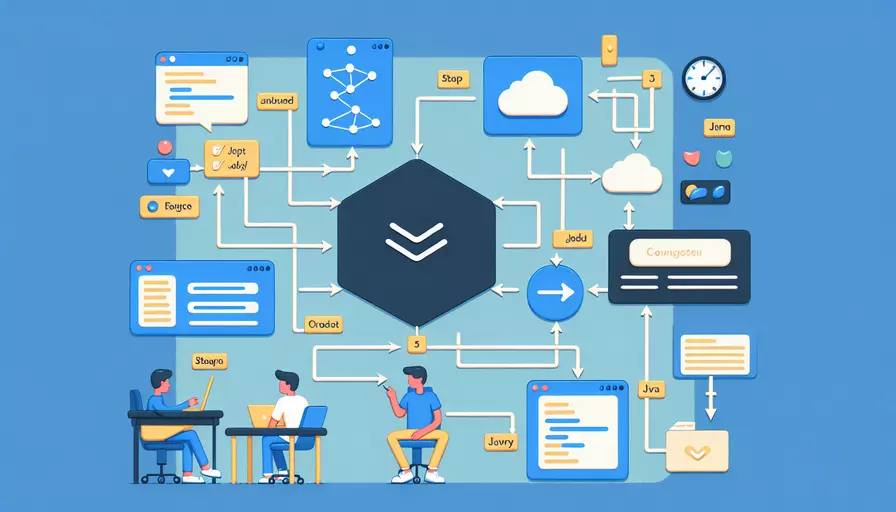
Vue调用后端Java可以通过以下几个步骤实现:1、配置后端API接口,2、使用Axios进行HTTP请求,3、处理响应数据。接下来,我们将详细介绍如何在Vue应用程序中调用后端的Java服务。
一、配置后端API接口
在开始之前,确保后端Java服务已经部署并且API接口可以被访问。常见的Java后端框架包括Spring Boot、Jersey等。假设我们使用Spring Boot来创建一个简单的API接口:
- 创建一个Spring Boot项目,并添加必要的依赖,例如Spring Web。
- 编写控制器类,定义API接口:
@RestController
@RequestMapping("/api")
public class ApiController {
@GetMapping("/data")
public ResponseEntity<String> getData() {
return ResponseEntity.ok("Hello from Java backend!");
}
}
- 启动Spring Boot应用,并确保API接口
/api/data可以通过浏览器或工具(如Postman)访问。
二、使用Axios进行HTTP请求
Vue.js推荐使用Axios库进行HTTP请求。首先,需要在项目中安装Axios:
npm install axios
接下来,在Vue组件中使用Axios来调用后端API接口:
- 在Vue组件中引入Axios:
import axios from 'axios';
- 在组件的生命周期钩子函数或方法中发起HTTP请求:
export default {
data() {
return {
responseData: null,
error: null,
};
},
mounted() {
this.fetchData();
},
methods: {
async fetchData() {
try {
const response = await axios.get('http://localhost:8080/api/data');
this.responseData = response.data;
} catch (error) {
this.error = error.message;
}
},
},
};
- 在模板中展示数据或错误信息:
<template>
<div>
<div v-if="responseData">{{ responseData }}</div>
<div v-else-if="error">{{ error }}</div>
<div v-else>Loading...</div>
</div>
</template>
三、处理响应数据
在实际开发中,后端返回的数据通常是JSON格式,前端需要对这些数据进行处理和展示。假设后端返回一个包含用户信息的JSON对象:
- 修改后端API接口,返回JSON数据:
@GetMapping("/user")
public ResponseEntity<Map<String, String>> getUser() {
Map<String, String> user = new HashMap<>();
user.put("name", "John Doe");
user.put("email", "john.doe@example.com");
return ResponseEntity.ok(user);
}
- 在Vue组件中处理JSON响应:
export default {
data() {
return {
user: null,
error: null,
};
},
mounted() {
this.fetchUser();
},
methods: {
async fetchUser() {
try {
const response = await axios.get('http://localhost:8080/api/user');
this.user = response.data;
} catch (error) {
this.error = error.message;
}
},
},
};
- 在模板中展示用户信息:
<template>
<div>
<div v-if="user">
<p>Name: {{ user.name }}</p>
<p>Email: {{ user.email }}</p>
</div>
<div v-else-if="error">{{ error }}</div>
<div v-else>Loading...</div>
</div>
</template>
四、处理复杂数据和错误
在实际项目中,前端可能需要处理更复杂的数据结构和错误情况:
- 处理复杂数据结构:
@GetMapping("/users")
public ResponseEntity<List<Map<String, String>>> getUsers() {
List<Map<String, String>> users = new ArrayList<>();
Map<String, String> user1 = new HashMap<>();
user1.put("name", "John Doe");
user1.put("email", "john.doe@example.com");
users.add(user1);
Map<String, String> user2 = new HashMap<>();
user2.put("name", "Jane Doe");
user2.put("email", "jane.doe@example.com");
users.add(user2);
return ResponseEntity.ok(users);
}
- 在Vue组件中处理和展示复杂数据:
export default {
data() {
return {
users: [],
error: null,
};
},
mounted() {
this.fetchUsers();
},
methods: {
async fetchUsers() {
try {
const response = await axios.get('http://localhost:8080/api/users');
this.users = response.data;
} catch (error) {
this.error = error.message;
}
},
},
};
- 在模板中展示用户列表:
<template>
<div>
<div v-if="users.length">
<ul>
<li v-for="(user, index) in users" :key="index">
<p>Name: {{ user.name }}</p>
<p>Email: {{ user.email }}</p>
</li>
</ul>
</div>
<div v-else-if="error">{{ error }}</div>
<div v-else>Loading...</div>
</div>
</template>
总结与建议
通过以上步骤,我们详细介绍了如何在Vue应用中调用后端Java服务的过程,包括配置后端API接口、使用Axios进行HTTP请求、处理响应数据以及处理复杂数据和错误。总结主要观点:
- 配置后端API接口,确保API可以被访问。
- 使用Axios进行HTTP请求,在Vue组件中调用API。
- 处理响应数据,将数据展示在前端页面。
- 处理复杂数据和错误,确保应用的健壮性。
建议在实际项目中,遵循以下几点:
- 统一管理API请求:可以创建一个单独的模块来管理所有API请求,便于维护和复用。
- 错误处理:详细处理可能出现的各种错误,提供友好的用户提示。
- 性能优化:对频繁请求的数据进行缓存,减少不必要的网络请求。
- 安全性:注意处理跨域问题,并对敏感数据进行加密传输。
通过这些步骤和建议,可以帮助开发者更好地在Vue项目中与后端Java服务进行交互。
相关问答FAQs:
1. Vue如何调用后端Java接口?
在Vue中调用后端Java接口可以通过使用Axios库来实现。Axios是一个基于Promise的HTTP客户端,可以用于发送HTTP请求。以下是一个简单的例子:
import axios from 'axios';
axios.get('/api/backend').then(response => {
console.log(response.data);
}).catch(error => {
console.error(error);
});
上述代码中,我们使用Axios发送一个GET请求到/api/backend接口,并在成功时打印出返回的数据,失败时打印出错误信息。
你需要确保后端Java应用已经正确配置了CORS(跨域资源共享),以允许Vue应用访问后端接口。你可以在后端的配置文件中添加以下配置:
@Configuration
public class CorsConfig {
@Bean
public WebMvcConfigurer corsConfigurer() {
return new WebMvcConfigurer() {
@Override
public void addCorsMappings(CorsRegistry registry) {
registry.addMapping("/api/**")
.allowedOrigins("http://localhost:8080") // 允许的前端域名
.allowedMethods("GET", "POST", "PUT", "DELETE") // 允许的HTTP方法
.allowCredentials(true); // 允许发送Cookie
}
};
}
}
请根据你的实际需求修改上述代码中的域名和允许的HTTP方法。
2. 如何在Vue中使用后端Java的数据?
一旦你成功地从后端Java接口获取到数据,你可以在Vue组件中使用这些数据进行展示或其他操作。以下是一个简单的例子:
<template>
<div>
<ul>
<li v-for="item in items" :key="item.id">
{{ item.name }}
</li>
</ul>
</div>
</template>
<script>
import axios from 'axios';
export default {
data() {
return {
items: []
};
},
mounted() {
axios.get('/api/backend').then(response => {
this.items = response.data;
}).catch(error => {
console.error(error);
});
}
};
</script>
上述代码中,我们在Vue组件的mounted生命周期钩子中发送了一个GET请求到后端Java接口,并将返回的数据赋值给组件的items数据属性。然后,在模板中使用v-for指令遍历items数组,并将每个元素的name属性渲染到页面上。
你可以根据实际情况修改上述代码,以适应你的数据结构和展示需求。
3. 如何在Vue中发送POST请求到后端Java接口?
在某些情况下,你可能需要向后端Java接口发送POST请求以提交数据。以下是一个简单的例子:
import axios from 'axios';
const data = {
username: 'john',
password: 'password123'
};
axios.post('/api/backend', data).then(response => {
console.log(response.data);
}).catch(error => {
console.error(error);
});
上述代码中,我们使用Axios发送一个POST请求到/api/backend接口,并将一个包含用户名和密码的数据对象作为请求的主体。在成功时,我们打印出返回的数据;在失败时,我们打印出错误信息。
你可以根据实际需求修改上述代码,以适应你的数据结构和后端Java接口的要求。注意,如果你的后端Java接口需要接收JSON格式的数据,请确保在请求头中设置Content-Type为application/json。
文章标题:vue如何调用后端java,发布者:worktile,转载请注明出处:https://worktile.com/kb/p/3645271

 微信扫一扫
微信扫一扫  支付宝扫一扫
支付宝扫一扫 